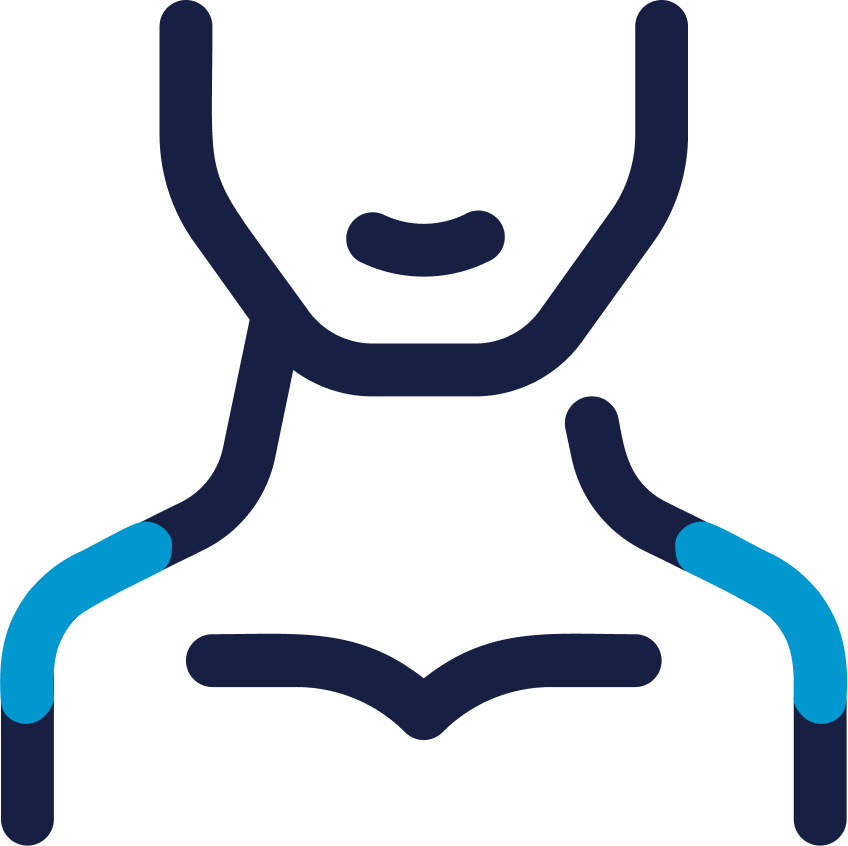
- Common Conditions
- /Shoulder

The shoulder joint is the most flexible and one of the most functionally important joints in the body. This joint makes it possible to reach, lift, and grasp; however, this flexibility makes the shoulder more prone to injuries, including fractures.
A fractured clavicle (the bone that connects the sternum or breastbone to the shoulder,) is one of the most common types of shoulder fractures. Also known as a broken collarbone, a fractured clavicle can impact people of all ages, and can range in severity.
In order to diagnose a clavicle fracture, your doctor or orthopaedic surgeon will:
Generally, a broken clavical will heal itself, without surgican intervention. Non-surgical treatment methods include:
In the case of a displaced fracture, surgery may be required. Surgery will realign the fractured ends of the broken bone and stabilize them so they can heal properly. Surgery generally involves using pins or plates, and screws, which hold the bone in the proper position during the healing process.
The healing time for a clavicle fracture will vary dramatically depending on age. Children can heal in a matter of weeks while adults may take several months.The following can help improve the recovery of a fractured clavicle:
The recovery process of a clavicle fracture can be slow, but following the recommendations made by your doctor will improve the process and restore the function of the shoulder.
The upper portion of the arm bone, called the humerus, forms two joints: the elbow joint and the shoulder joint. The proximal humerus is located near the upper end of the arm bone that helps to form the shoulder joint.
Proximal humerus fractures are most common in elderly patients who suffer from osteoporosis, but these injuries can occur at any age and typically result from falls or collisions.
The prognosis of a proximal humerus fracture is dependent on several factors, including:
Fractures of the proximal humerus are classified as:
The majority of proximal humerus fractures are minimally displaced and can be healed with non-surgical methods, including:
If the bone is displaced, surgery may be needed. Plates, screws, or pins will be used to repair the multiple fragments of the bone. In extreme cases, shoulder replacement surgery may be necessary.
It takes approximately four to eight weeks for this type of fracture to heal to a point where restrictions is are no longer needed. By twelve weeks, good strength should return, however, it may take between six to twelve months for the injury to fully heal.
The scapula, commonly referred to as the shoulder blade, is a triangular-shaped bone, and when this bone that is part of the shoulder structure. Scapula fractures are usually the result of a blunt trauma, such as a motor vehicle accident or falling from a height.
When this type of fracture occurs, one or more parts of the scapula may be fractured:
In order to properly diagnose a scapular fracture, an orthopedic surgeon should perform a thorough evaluation of the damaged scapula.
The majority of scapular fractures are not seriously displaced, which means that they can be treated conservatively. Conservative treatment options generally include:
During the recovery period, which can take anywhere from six months to one year, passive stretching exercises should be continued until the complete range of motion in the shoulder returns.
The clavicle (collarbone) is the bone in your body that's perhaps the easiest to break because of where it's located and its role. While directly hitting it can break it, you can also break it by a transfer of shock, meaning if you fall on your outstretched hand or your shoulder, the shock of the force to your collarbone can cause a fracture.
This type of fracture is a severe injury to your humerus, and requires immediate treatment to prevent loss of shoulder function. A collision, fall, or other traumatic event are possible causes of a humeral fracture. Surgical intervention by your orthopaedic surgeon may be required depending on the type of fracture and specific location of the fracture.
Regardless of whether you need minimally invasive surgery or nonsurgical treatment, Dr. O'Grady and his staff will recommend physical therapy to help restore the function of your shoulder safely so you can get back to your normal activities.
These types of fractures are usually more common in the elderly who are suffering from osteoporosis, or in professional athletes; however, anyone at any age can get this type of injury due to a collision or fall.
Most scapular fractures aren't severely displaced (pieces of your bone shift and separate out of position). This means your doctor can treat them with conservative treatment options such as:
If you have a serious displacement or there's damage to your glenoid, you may require surgery. In some cases, you may even be able to get minimally invasive surgery, but this is dependent on the severity and location of the fracture.
With a shoulder fracture, you might experience symptoms right after your injury that include:
With most fractures, emergency medical expert care is needed. If you're experiencing any of these above symptoms you should seek immediate medical attention.
As soon as you fracture your shoulder, the healing process starts. Your body forms a callus and a blood clot, and osteocytes (bone cells) begin to grow around your fracture. These cells begin growing towards one another and absorb the callous to close the fracture. Your complete recovery could take anywhere from six months to one year. Your doctor will have you do some passive stretching exercises until you gain back your complete range of motion.

